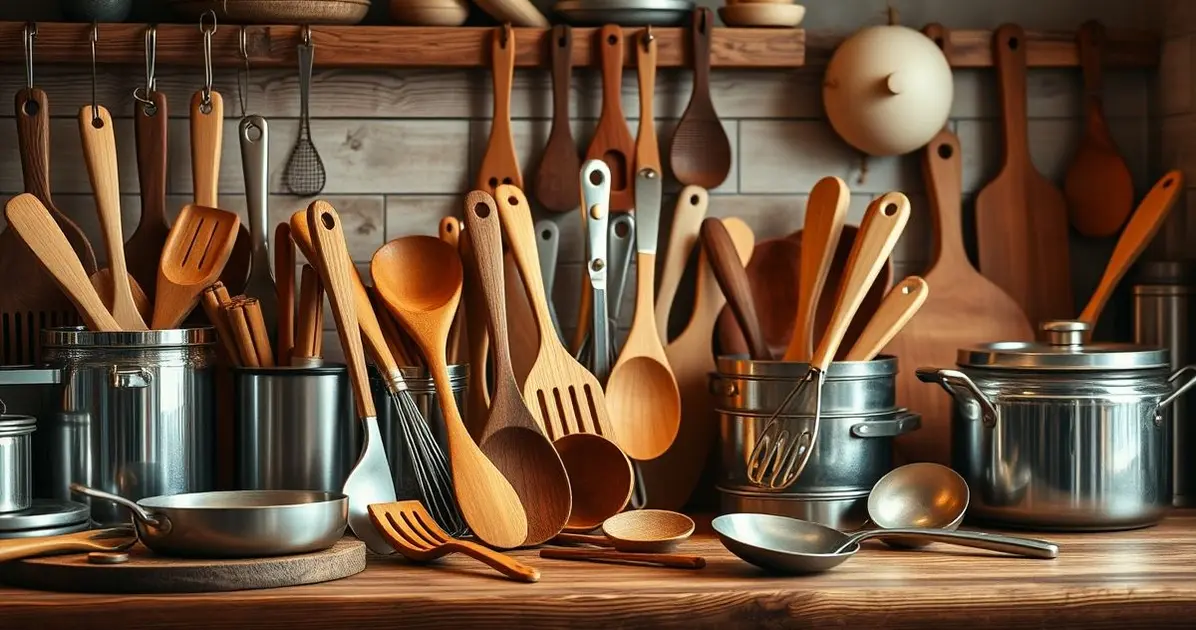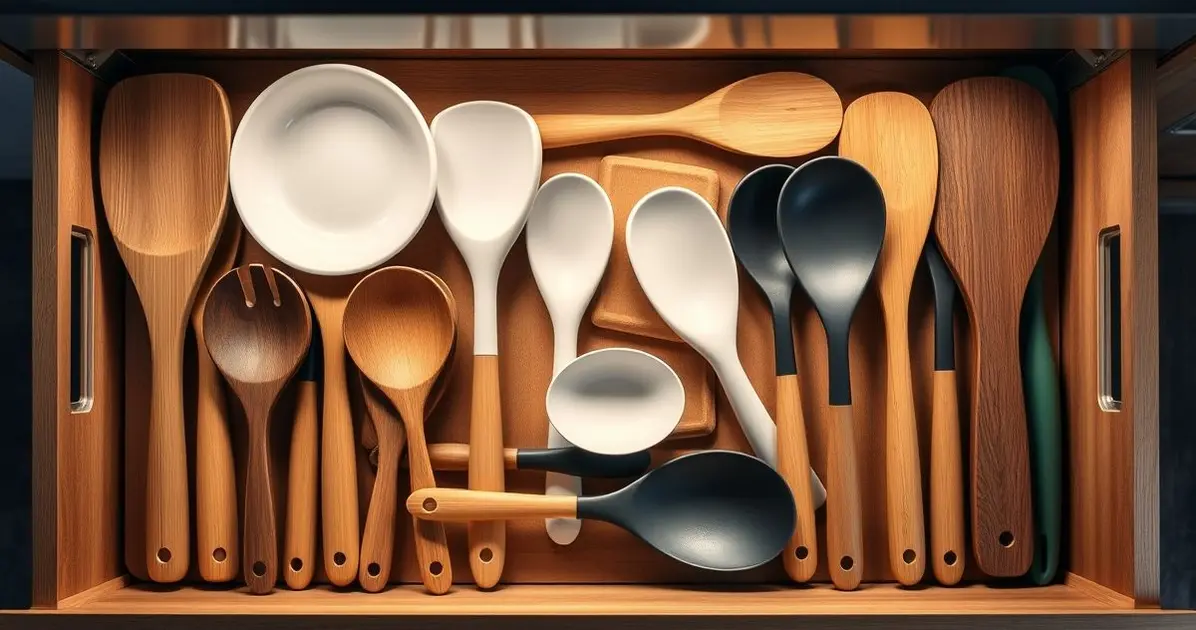Cooking tools and equipment are made from a variety of materials that influence their performance and durability. Common materials include stainless steel, wood, silicone, and ceramic, each offering unique benefits for different culinary tasks.
What material are cooking tools and equipments

The choice of material for cooking tools and equipment is crucial for their functionality and safety. Stainless steel provides durability and ease of cleaning, while wood offers a classic aesthetic. Silicone is flexible and heat-resistant, perfect for modern kitchens.
Stainless Steel: Durability and Versatility
Stainless steel is a top choice for many cooking tools and equipment, and for good reason! This material is renowned for its durability and versatility, making it a staple in kitchens around the world.
One of the standout features of stainless steel is its resistance to rust and corrosion. This means that whether you’re using it for frying pans, pots, or utensils, you can trust that it will stand the test of time. Unlike other materials that may wear down or degrade with frequent use, stainless steel maintains its integrity, ensuring that your cooking tools will last for years.
Another significant advantage of stainless steel is its ability to withstand high temperatures. This makes it perfect for tasks that require intense heat, such as searing meats or boiling water. It also distributes heat evenly, which is crucial for cooking food thoroughly without hot spots.
Stainless Steel: Durability and Versatility
Moreover, stainless steel is non-reactive, meaning it won’t interact with acidic or alkaline foods. This property is particularly important when preparing dishes like tomato sauce or citrus-based recipes, as it ensures that the flavors remain pure and untainted.
Cleaning and maintenance are a breeze with stainless steel. Most pieces are dishwasher safe, and even if you choose to wash them by hand, a simple soap and water solution will do the trick. For tougher stains or burnt-on food, a little baking soda can work wonders without scratching the surface.
In summary, stainless steel is a versatile and durable material that can elevate your cooking experience. Whether you’re a professional chef or a home cook, investing in high-quality stainless steel tools can help you achieve delicious results consistently.
Cast Iron: Heat Retention and Cooking
Cast iron cookware is a beloved choice for many cooking enthusiasts, and it’s easy to see why. This material is celebrated for its superior heat retention and ability to provide even cooking results, making it an essential tool in any kitchen.
One of the standout features of cast iron is its exceptional heat retention. Once heated, cast iron maintains its temperature for a long time, allowing for consistent cooking. This is particularly beneficial when searing meats or baking dishes, as the even heat distribution helps achieve that perfect golden crust.
Moreover, cast iron is incredibly versatile. You can use it on the stovetop, in the oven, or even over an open flame. Whether you’re frying, sautéing, baking, or braising, cast iron can handle it all. This adaptability makes it a favorite among chefs who appreciate its ability to transition seamlessly from one cooking method to another.
Seasoning and Maintenance
Another unique aspect of cast iron cookware is its ability to develop a natural non-stick surface over time, known as seasoning. When properly maintained, this seasoning not only enhances the non-stick properties but also adds flavor to your dishes. To season your cast iron, simply apply a thin layer of oil and bake it in the oven. With regular use and care, your cast iron will improve, becoming more effective and easier to cook with.
However, it’s essential to note that cast iron requires a bit more maintenance than other materials. It should be hand washed and dried immediately to prevent rusting. Additionally, avoid soaking it in water for extended periods, as this can damage the seasoning. With a little care, your cast iron cookware can last a lifetime and even be passed down through generations.
In conclusion, cast iron cookware is a fantastic investment for anyone looking to elevate their cooking. Its heat retention, versatility, and unique seasoning properties make it a powerful ally in the kitchen, ensuring delicious results every time.

Non-Stick Coatings: Easy Cleanup
Non-stick cookware has revolutionized the way we cook, offering a convenient solution for those who want to enjoy delicious meals without the hassle of stubborn food residues. The primary appeal of non-stick coatings lies in their ease of cleanup and cooking efficiency.
One of the biggest advantages of non-stick cookware is that it allows you to cook with less oil or butter. This not only helps in preparing healthier meals but also makes it easier to flip and remove delicate foods like eggs, pancakes, or fish without them sticking to the surface. Imagine flipping a pancake without it tearing apart—non-stick coatings make this possible!
Non-Stick Coatings: Easy Cleanup
Cleaning up after cooking is a breeze with non-stick pans. Most of the time, a simple wipe with a sponge and warm soapy water is all it takes to keep them in pristine condition. Unlike traditional cookware, which may require scrubbing or soaking, non-stick surfaces minimize the effort needed to maintain them.
However, it’s important to be mindful of the materials used in non-stick coatings. Many modern non-stick pans are made with PTFE (Teflon) or ceramic coatings, both of which offer excellent non-stick properties. While Teflon is durable and effective, it’s essential to avoid using metal utensils that can scratch the surface. Instead, opt for wooden, silicone, or plastic utensils to prolong the life of your non-stick cookware.
When using non-stick pans, be cautious about cooking at high temperatures. Overheating can degrade the coating and lead to potential health concerns. Most manufacturers recommend using non-stick cookware over low to medium heat to ensure longevity.
In summary, non-stick coatings provide an incredibly convenient cooking experience, making meal preparation and cleanup a walk in the park. By choosing quality non-stick cookware and following proper care guidelines, you can enjoy delicious meals with minimal fuss!
Silicone and Bamboo: Modern Alternatives
In recent years, silicone and bamboo have emerged as popular alternatives to traditional cooking materials, each offering unique benefits that cater to modern cooking needs. Let’s explore these innovative materials and why they are gaining traction in kitchens everywhere.
Silicone is a flexible and heat-resistant material that has become a favorite in both cooking and baking. One of its standout features is its ability to withstand extreme temperatures, making it suitable for use in ovens, microwaves, and even freezers. Silicone bakeware, such as muffin pans and baking mats, allows for easy release of baked goods without the need for greasing, resulting in perfectly shaped treats every time.
Another significant advantage of silicone is its non-stick properties. Unlike traditional metal pans, silicone doesn’t require additional oil or butter, which can help you create healthier dishes. Moreover, cleaning silicone is a breeze; most silicone items are dishwasher safe, and a quick wash with soap and water is often enough to keep them in good condition.
On the other hand, bamboo is a natural and eco-friendly choice for cooking utensils and cutting boards. Bamboo is lightweight yet incredibly durable, making it perfect for everyday use. Its natural antibacterial properties help keep your kitchen hygienic, and it doesn’t absorb odors or stains as easily as some other materials.
Bamboo utensils are gentle on non-stick cookware, preventing scratches and extending the life of your pans. Plus, they add a touch of warmth and style to your kitchen, making them not just functional but also aesthetically pleasing.
Both silicone and bamboo are sustainable options that align with a growing focus on environmentally friendly cooking practices. By choosing these materials, you’re not only enhancing your cooking experience but also making choices that are better for the planet.
In conclusion, silicone and bamboo are modern alternatives that offer unique benefits for today’s cooks. Whether you’re baking, cooking, or preparing ingredients, integrating these materials into your kitchen can lead to more efficient and enjoyable culinary adventures!
Conclusion
In summary, understanding the materials used in cooking tools and equipment is essential for anyone looking to enhance their culinary experience.
From the durability and versatility of stainless steel to the heat retention of cast iron, each material offers unique benefits that can elevate your cooking techniques.
Non-stick coatings provide the convenience of easy cleanup, while silicone and bamboo present modern, eco-friendly alternatives that cater to diverse cooking needs.
By choosing the right materials for your kitchen, you can ensure delicious results and enjoy the cooking process to its fullest.
Whether you’re a seasoned chef or just starting your culinary journey, making informed choices about your cooking tools can significantly impact your kitchen experience.
Embrace these materials, and watch your cooking skills flourish!
FAQ – Frequently Asked Questions about Cooking Tools and Materials
What are the benefits of using stainless steel cookware?
Stainless steel cookware is durable, resistant to rust and corrosion, and distributes heat evenly, making it versatile for various cooking techniques.
How do I maintain cast iron cookware?
To maintain cast iron, wash it by hand, dry immediately, and regularly season it with oil to maintain its non-stick surface and prevent rust.
Are non-stick coatings safe for cooking?
Yes, non-stick coatings are safe as long as you avoid overheating them and use appropriate utensils to prevent scratching.
What are the advantages of silicone bakeware?
Silicone bakeware is flexible, heat-resistant, non-stick, and easy to clean, making it ideal for baking and cooking.
Why should I choose bamboo utensils?
Bamboo utensils are lightweight, durable, naturally antibacterial, and gentle on non-stick cookware, plus they are eco-friendly.
How can I ensure my cooking tools last longer?
To prolong the life of your cooking tools, follow manufacturer care instructions, avoid using metal utensils on non-stick surfaces, and maintain your cast iron cookware properly.
See more
Discover plenty of easy and delicious recipes you can make at home, from hearty dinners to indulgent desserts and wholesome breakfasts.




